"Sturmgever" in the war
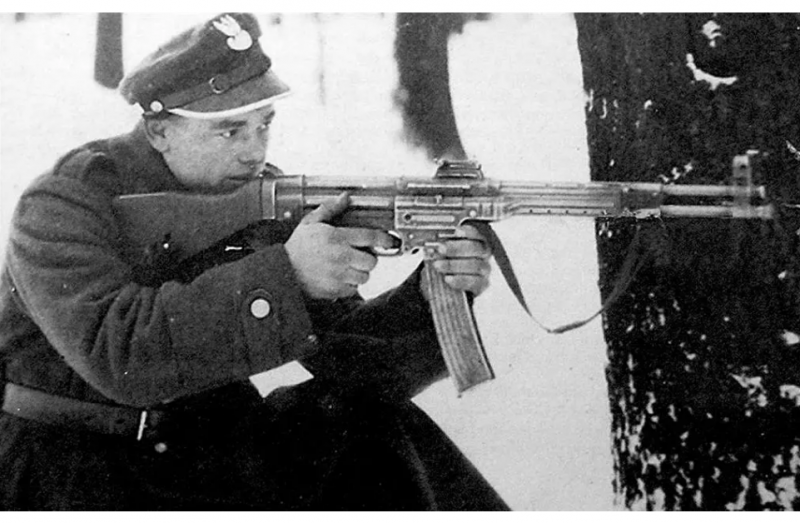
Polish soldier during testing of MKB 42(N) from Haenel
Why do the stars burn,
Why do the stars burn?
Not warm.
Get me a gun
Find me a gun,
Buy me a machine.
Quicker.
"Why do the stars burn"
song from the movie "Dear Boy" (1974)
music D. Tukhmanova
sl. L. Derbeneva
stories about weapons. By 1941, it became clear to the Germans that it was necessary to act more actively towards the creation of new weapons. Although various experimental cartridges had been developed to varying degrees by this point, the Army decided to select the Polte 8x33mm Kurzpatrone ("short cartridge") cartridge. It used the Spitzer bullet, and the cartridge itself was based on the design of the standard 7,92x57 mm Mauser rifle cartridge. Simply, the cartridge from the original 7,92x57 mm was reduced to 7,92x33 mm Kurtz. It was clear that this was not an ideal solution, but there was a war going on, and this made it possible to minimize logistical problems.
At the same time, the Mauser automatic rifle of 7,92x57 mm caliber was created, which became one of the first rifles of this type with “straight-line” recoil and a raised sight line above the axis of the barrel bore. But it turned out to be not good enough for mass production. Therefore, the development of an assault rifle chambered for a smaller cartridge was continued.
Models MKb 42(N) from Haenel and Walter MKb 42(W) appeared. Moreover, if the design of the Haenel assault rifles was, let’s say, more traditional, it contained a gas piston connected to the bolt following the example of a number of samples known at that time, then the Walter assault rifle had a piston mounted on the barrel, and on it several holes, the powder gases flowing from which pressed on this piston. The scheme was somewhat simpler than the previous one, but the military did not like it.
A total of 163 such machines were assembled. They took part in army tests in 1942, but then were not used anywhere else.
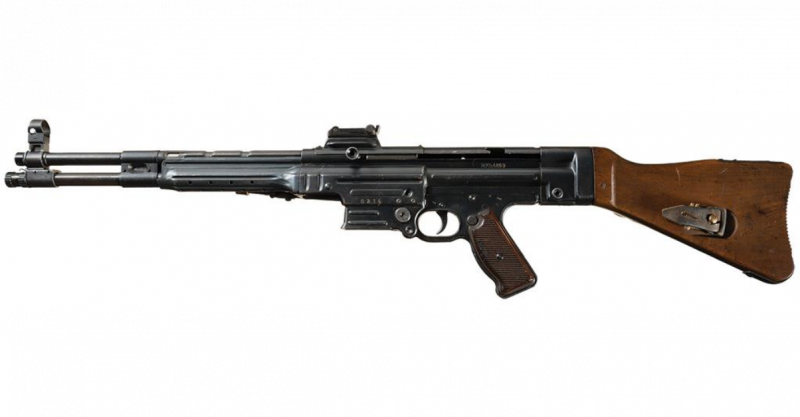
MKb 42(H). Left view. Photo by Rock Island Auction Company
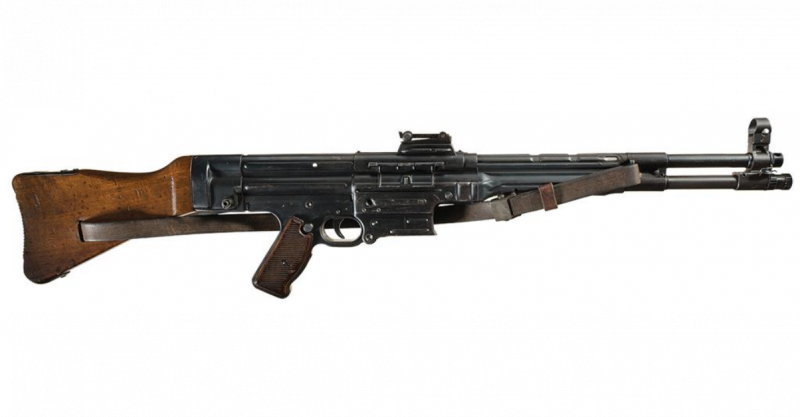
He is the same, viewed from the right and with a belt. Photo by Rock Island Auction Company
The MKb 42(H) or Maschinenkarabiner 42(H) turned out to be more successful, and it also fired from a closed bolt, which the military considered a big plus.
Over time, Hitler learned about these military tests and ordered to immediately stop all work on new weapons, and even new ammunition. But they decided to continue production.
Moreover, since July 1942, the Gustloff company began developing an automatic carbine for conventional rifle cartridges as ... cover, since Hitler categorically disagreed with the use of Kurz ammunition. To maintain the MKb 42(H) development program, the Ordnance Directorate renamed the weapon Maschinenpistole 43 (MP 43) and, with several improvements, declared the weapon an upgrade to existing submachine guns.
Of course, the Germans failed to make the MP43 a full replacement for the 98k rifle. This goal turned out to be unattainable. The MP 43 cartridge was too weak for rifle grenades, too inaccurate for sniping, and the weapon was too short for bayonet fighting.
As a result, in September 1943 it was decided that the MP43 would complement, rather than replace, the 98k. As a result, the base of the optical sight, the extended muzzle thread of the grenade launcher, and the bayonet lug were removed.
Adolf Hitler eventually discovered the deception and stopped the program again. In March 1943, he allowed it to resume for evaluation purposes only. The evaluation, which lasted six months until September 1943, yielded positive results, and Hitler allowed the MP 43 program to continue and mass production to begin.
The guns made extensive use (for the 1940s) of modern, economical stamped steel components rather than machined parts. The first MP 43s were transferred to the Waffen-SS: in October 1943, some of them ended up with the 93rd Infantry Division on the Eastern Front.
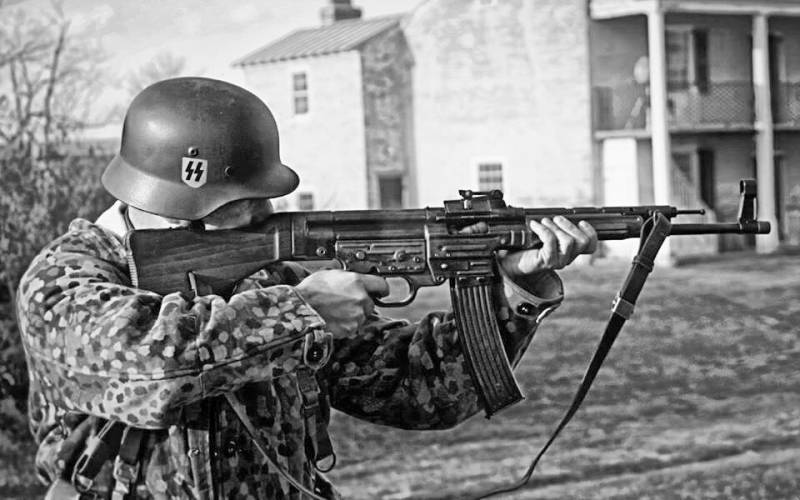
Waffen-SS with MP43...
In April 1944, Hitler showed some interest in testing the new weapon and ordered it to be renamed the MP 44. In July 1944, at a military meeting about the Eastern Front, when Hitler asked what they needed, the general exclaimed: “More of these new rifles!” This exclamation caused some confusion. It is believed that Hitler's response was: "What new rifle?" But, having seen the MP 44 in action, he personally gave it the name Sturmgewehr, although it is quite possible that this is nothing more than a legend.
Then it was renamed again to Sturmgewehr 44 (StG 44) to emphasize its belonging to a new class of weapons. This designation translates as “Assault rifle model 1944”, and with this the term “assault rifle” was introduced into circulation.
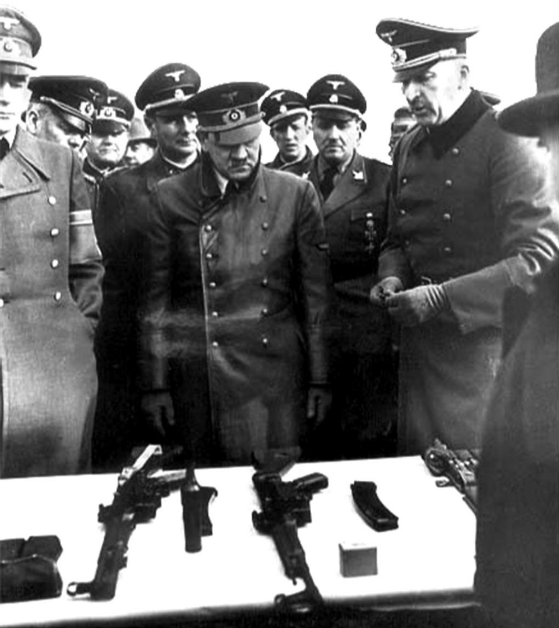
New types of small arms are demonstrated to Hitler
Numerous reports and company correspondence show that Hitler was often told about the stages of development of this machine gun. His fears may have been due not to the fact that he was against the idea itself, but to his reluctance to send new weapons to the front in small quantities.
German industry was unable to replace 12 million Kar 98k rifles in a short time, so the Wehrmacht's already strained logistics structure would have to maintain supplies of one more cartridge. Although the Sturmgewehr required special tools to make, it required fewer materials and was faster and easier to fabricate than the 98k.
So introducing a new machine gun in quantities that would not make an impression at the front would be counterproductive. However, by the end of the war a total of 425 StG 977s of all types had been produced, and work began on the next example, the StG 44.
The machine gun proved to be a valuable weapon, especially on the Eastern Front, where it first came into use. A properly trained soldier with the StG 44 could effectively engage targets at greater ranges than with the MP 40, and was more useful than the 98k in close combat. It has also been found to be exceptionally reliable in extreme cold.
The StG 44 had a significantly longer firing range than the PPSh/PPS submachine guns, the ability to switch fire modes, and amazing accuracy. Its muzzle velocity was 685 m/s compared to 760 m/s for the 98k, 744 m/s for the British Bren, 600 m/s for the M1 Carbine and 365 m/s for the MP40.

“Walter” G-43 – the “Walter” company continued to work on an automatic rifle in 1943. But she was never able to create a product that was truly high-quality in all respects, and also cheap! Photography by Alain Dobress

The same rifle. Right view. Photography by Alain Dobress
The 1st Infantry Division of Army Group South and the 32nd Infantry Division of Army Group North, both of which had previously suffered heavy losses on the Eastern Front, were selected to receive the new "Gever". However, due to a shortage of ammunition, the 1st ID was the only one fully equipped with the StG 44.
The Kar 98k remained as a specialist weapon for sniping and rifle grenade shooting, while the MP 40 was used by vehicle drivers, gun crews and officers. When attacking enemy positions, riflemen from 98k used grenades against it at close range, and riflemen from StG 44 fired in semi-automatic or automatic modes to suppress it.
In a combat situation, it turned out that the magazine pusher spring quickly fails if the magazine is loaded with the required number of rounds, so soldiers were instructed to load no more than 25 rounds into it in order to reduce wear on the spring. In January 1945, a magazine with a fixed plug was introduced, also limiting its capacity to 25 rounds.
Although the StG 44 was capable of fully automatic fire, German soldiers were also ordered to use it primarily in semi-automatic mode. The fully automatic mode was supposed to be used only in emergency cases, in short bursts of two or three shots.
Germany had problems with ammunition logistics, so Hitler's calculations were partially correct: 200 additional workers were needed for the originally planned 86 million rounds of ammunition per month, but they were not available. And there was nowhere to get them. The planned production of 000 million cartridges per month from February 1944 was completely utopian for German industry. Since February 400, this number has dropped to a realistic 1945 million.
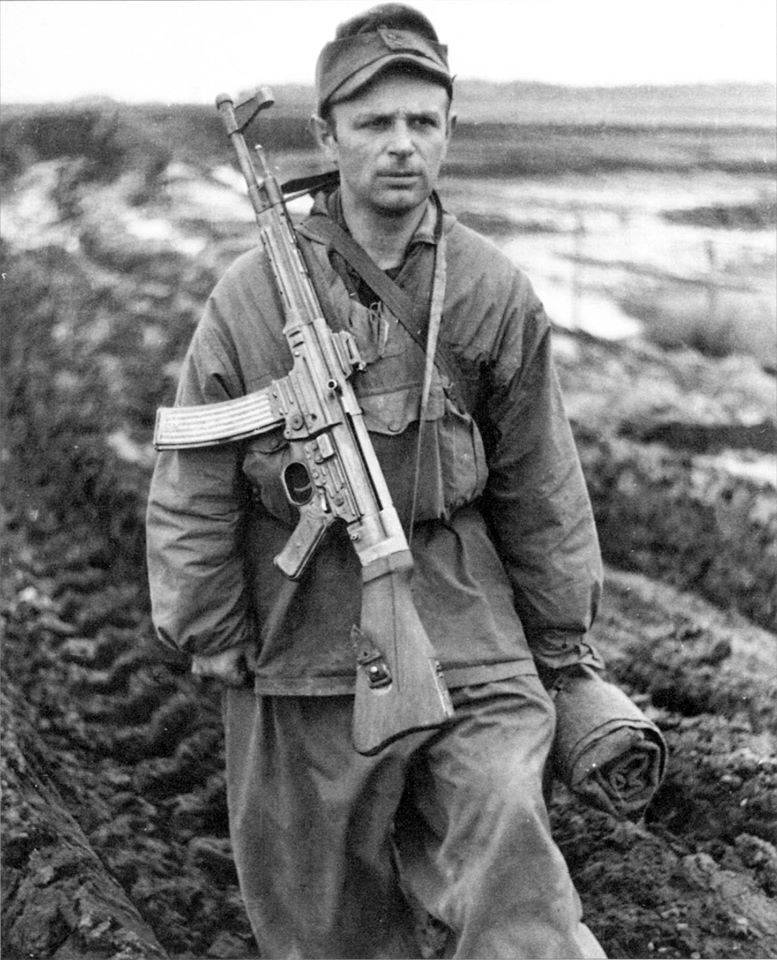
And this is a front-line photo from StG 44...
One of the unusual additions to the design of this machine gun was the “Krummlauf” - a curved barrel attachment with a periscope sight for shooting from around a corner or trench from a safe position. It was produced in several versions: version “I” for use in infantry, version “P” for use in tanks (to cover blind spots in the short radius around the tank, to protect against attacking infantry), variants with an inclination angle of 30°, 45°, 60° and 90°, a version for the StG 44 and one for the MG42.
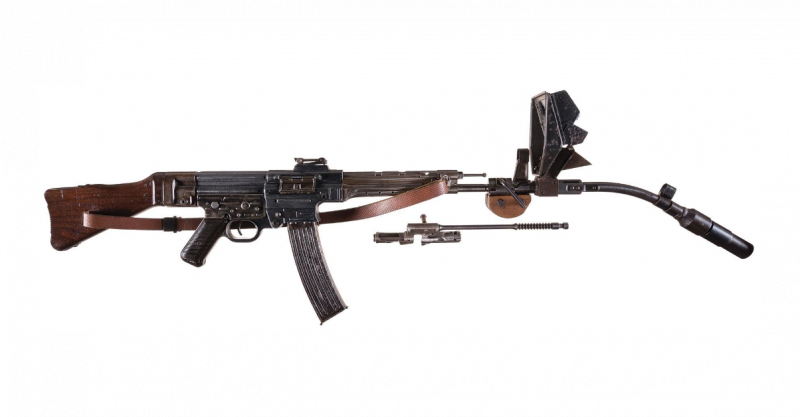
StG 44 with Krummlauf attachment, option “I”. By the way, the barrel has an attachment for firing rifle grenades. Photo by Rock Island Auction Company
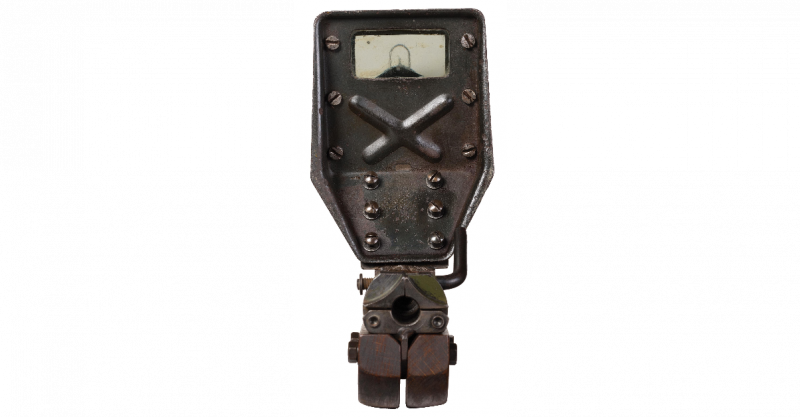
This is how the front sight was visible in the sight of the Krummlauf attachment. Photo by Rock Island Auction Company
But only the "I" 30° version for the StG 44 was produced in large quantities. These barrel attachments had a very short service life - approx. 300 rounds for the 30° version and 160 rounds for the 45° version. The 30° model could hit a target measuring 35x35 cm at a distance of 100 m.
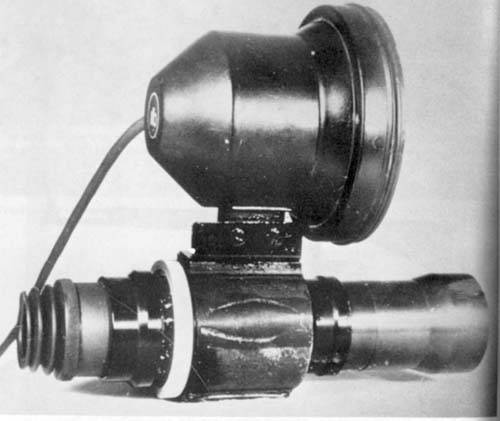
German sight Zielgerät 1229
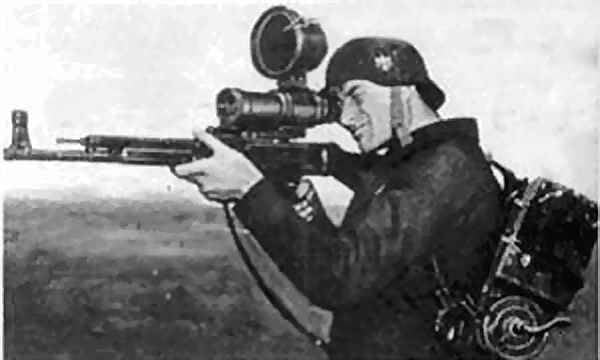
Zielgerät 1229 mounted on StG 44. The device weighed about 2,25 kg. It (and the infrared equipment) also came with a 13,5 kg battery and batteries to power the infrared device. The batteries were placed on a support frame (Tragegestell 39) on the soldier’s back, so such a “night gunner” was more than heavily loaded!
The StG44 also featured the Zielgerät 1229 infrared sight, codenamed "Vampir". This device consisted of a large infrared lamp mounted above the shutter and a sight itself, which allowed one to see in the dark.
"Vampire" could work for only 15 minutes, but could see within 200 meters in complete darkness. In this case, a conical flash suppressor was added to the barrel so that the muzzle flash would not blind the shooter.
To be continued ...
Information